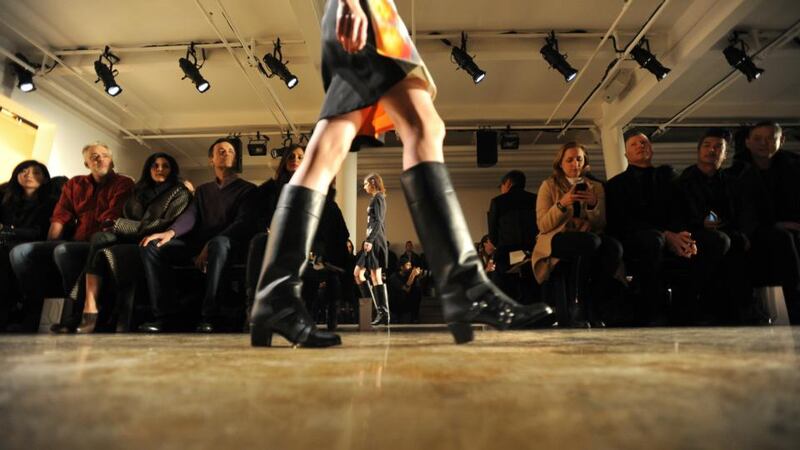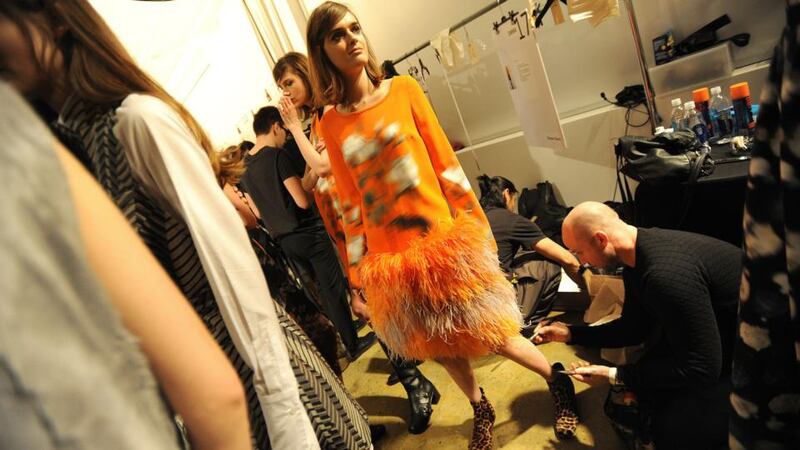The week before Fashion Week in New York, now underway, is perhaps the busiest in the city’s apparel industry. Frantic designers rush around looking for gold buttons with blue inlay, for seamstresses to make pleats and for patternmakers with spare fabric. They make modifications to dresses in real time under enormous deadline pressures.
Yet when eyes eventually fall on the runways, they witness virtually glitch-less shows and talk-of-the-town creativity. How does New York’s fashion industry continually pull off Fashion Week year after year? The answer lies in a complex economic system whose informal origins date to the mid-19th century and whose central idea rests on geographical proximity. We’re talking about the Garment District, eight blocks in Manhattan where designers, wholesalers, manufacturers, fabric sellers, button makers, and seamstresses all work.
Something in the air


The idea that highly specialized concentrations of an industry like the Garment District offer significant economic advantages is hardly revolutionary. The automobile, steel, mining and textile industries similarly occupied proximate physical space, sharing resources, labor and information to their great economic benefit. As the great economist Alfred Marshall observed in 1890, industries that clustered together generated economic growth by virtue of something “in the air.”
Exactly what is “in the air” in places like the Garment District? For a long time, discussions on the benefits of economic clusters, or agglomeration economies as urban planners call them, have been mainly theoretical or qualitative. Interviews, case studies and ethnographies tell us proximity matters to certain industries. Think Silicon Valley, Wall Street or Hollywood. Therefore, so the argument goes, cities ought to push policies that encourage the growth of spatially concentrated economic activity. But why and how - these clusters work has remained a mystery.
To find out answers to these questions, we tracked 77 fashion designers working in the Garment District and the larger New York region over two weeks in July 2011. Using their cellphone data and a social-media tool we tracked their geographical movements and documented exactly where they went and when, compiling a real-time, minute-by-minute, day-by-day, snapshot of what they did.
The designers voluntarily let us in on their activities - picking up a fabric, meeting with a manufacturer, grabbing a cup of coffee ? by “checking-in” to Foursquare, a social media application that allows users to identify precisely where they are and what they are doing. To gauge the economic importance of the Garment District to the broader region, we studied the work lives of designers with offices in the district and those with addresses in New Jersey and the other boroughs. A majority of our sample worked outside the Garment District.
It turned out that the benefits of the district’s agglomeration economies were not confined to eight blocks in Manhattan, but spread evenly across the region. Having an office in the Garment District was not as important as the existence of the area itself. Seventy-seven percent of all trips the designers made were to the Garment District, and 80% of the businesses they visited were located there. Not only that, regardless of where the designers’ offices were located, they all similarly interacted with manufacturers, wholesalers and suppliers, spending almost the same amount of time with them. The difference between Garment District-based designers and outsiders was a mere 10 minutes.
But what the designers actually did from 10 am to 6 pm (the hours most kept) revealed no set patterns. When we studied the timing of their trips to manufacturers, wholesalers or suppliers, we found no meaningful pattern, regardless of the size of the firm. Every day was a new day.
Herein may lie the magic - what Marshall said was “in the air” - of economic clusters and their importance to cities. All designers need the same basic materials and labor to make a dress. But how they individually pursue and use those resources ? and how they respond to the changing demands of realizing their conceptions ? is a key component of their creative process. The Garment District’s agglomeration economies foster the freedom necessary for creativity to thrive, which is part and parcel of how great dresses are made in the first place. What we think is raw creativity - the electric energy of Marc Jacobs and Anna Sui or the exciting parties reported in the media - is quite a practical matter.
The great urbanist Jane Jacobs once remarked that “diversity is natural to big cities.” Her point was that the intermingling of different firms and industries that work together to produce things and ideas is a central feature of an urban economy and accounts for its ongoing vibrancy. And our study shows that this sharing is much wider geographically than previously thought.
Creativity and its economic impact - whether producing a wrap dress or a semiconductor - is rarely an act of genius in isolation. It instead is the interworkings and interventions of a highly efficient and effective cluster of firms and those who work for them.
This phenomenon unfolds in particular places, and those special places must be preserved if we want to keep our cities bright and our industries innovative. Let that be a lesson as we watch the runways and the flashing lights.
- The New York Times News Service








